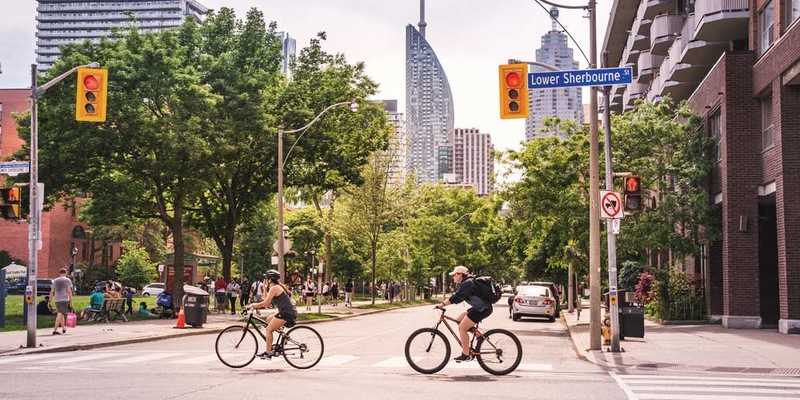
If you are not redirected within 30 seconds, please click here to continue.
Samedi: 10h – 16h HAE

If you are not redirected within 30 seconds, please click here to continue.
If you are not redirected within 30 seconds, please click here to continue.
How auto insurance works if you hit a cyclist or pedestrian

As double-digit temperatures settle in, more people are out and about enjoying the spring weather. But that also means there are more people to account for when navigating busy streets as a driver. Unfortunately, cyclists and pedestrians alike can easily go unnoticed if you’re not looking for them.
While staying alert is your best defence against an unwanted collision, preparing for any outcome can help you handle a potential run-in with a non-motorized vehicle, such as a bicycle, or pedestrian. Understanding how your auto insurance policy functions in either scenario can help ensure proper protection against damages or injuries sustained by either party involved.
Does your auto insurance protect you against damages or injuries caused to a cyclist or pedestrian?
Ideally, you can avoid a collision with a person or cyclist by following preventative driving tips. However, your auto insurance policy can protect you in different ways if you’re found at fault for a collision with a cyclist or pedestrian, depending on what province you live in. This protection falls under the third-party liability coverage portion of your policy.
- In Ontario, your standard policy includes third-party liability coverage, which can cover damages to a cyclist’s bike and their physical injuries up to your policy limit. The mandatory minimum coverage for this section of your policy is $200,000 and can apply if a cyclist or pedestrian seeks legal action against you after a collision.
- In Alberta, your third-party liability coverage starts at a mandatory minimum of $200,000. However, 98% of drivers increase their limit to $1,000,000, according to the province’s Automobile Insurance Rate Board.
- In Quebec, your mandatory basic liability coverage will cover a cyclist or pedestrian’s property damage to a minimum limit of $50,000 in the province. However, this coverage only includes bodily injury to others if you’re driving outside Quebec. This is because you can’t be sued as an at-fault driver in Quebec but can be in other jurisdictions.
- If you live in B.C., the Insurance Corporation of British Columbia (ICBC) is changing their policies to ensure they cover serious injuries endured by cyclists and pedestrians, regardless of fault.
“If a driver of a vehicle injures a pedestrian, cyclist, or any other person, the injured individual may have a legal claim for compensation against the at-fault driver,” says Sivan Tumarkin, national co-managing partner of personal injury and employment law firm Samfiru Tumarkin LLP. “The at-fault driver’s automobile insurance company should respond to such a legal claim for damages.”
Otherwise, according to Tanisha Kishan, RATESDOTCA expert and chartered insurance professional, if the cyclist has their own auto insurance policy, they can proceed with their own accident benefits coverage for injuries sustained. Regardless, a claim made on either end will go through a thorough examination to ensure adequate compensation.
Are your damages or injuries covered after hitting a cyclist or pedestrian?
According to Kishan, in most cases, a cyclist would be treated as a pedestrian if hit by a vehicle. Therefore, damage to your vehicle would only be covered if you had collision insurance. This is because in Ontario, for example, the direct compensation – property damage (DCPD) portion of your standard policy only applies if you were not at fault, if there was at least one other vehicle involved, if the collision occurred in Ontario, and if the other vehicle is insured in Ontario.
In any case, your personal injuries would be covered under the accident benefits section of your standard, mandatory auto policy.
Regardless of who is at fault, be sure to call 911 if it’s clear either party has been injured.
Will your auto insurance rate be affected?
If you’re involved in an at-fault collision of any nature, your car insurance rate may be affected at renewal. A claim that requires repairs or the company to pay out for liability could increase your personal premium.
“When a claim is reported to the insurer, it will be reviewed by a claim adjuster through an investigation,” says Elliott Silverstein, director of government relations at CAA Insurance Company. “As part of the investigation, the claim adjuster will review loss details from involved parties, police reports to confirm if there are any charges laid, video footage of the accident if it’s available, and the damages to the insured’s vehicle.”
It’s a good idea to compare car insurance rates near the end of your term to see if you can get a more affordable rate with another company in Canada. Different providers may weigh your risk differently and offer different rates according to that risk. Shopping around for a lower insurance rate may help you secure a lower rate even if a collision is impacting your premium.
Don't waste time calling around for auto insurance
Use RATESDOTCA to shop around, and compare multiple quotes at the same time.
Get money-saving tips in your inbox.
Stay on top of personal finance tips from our money experts!









